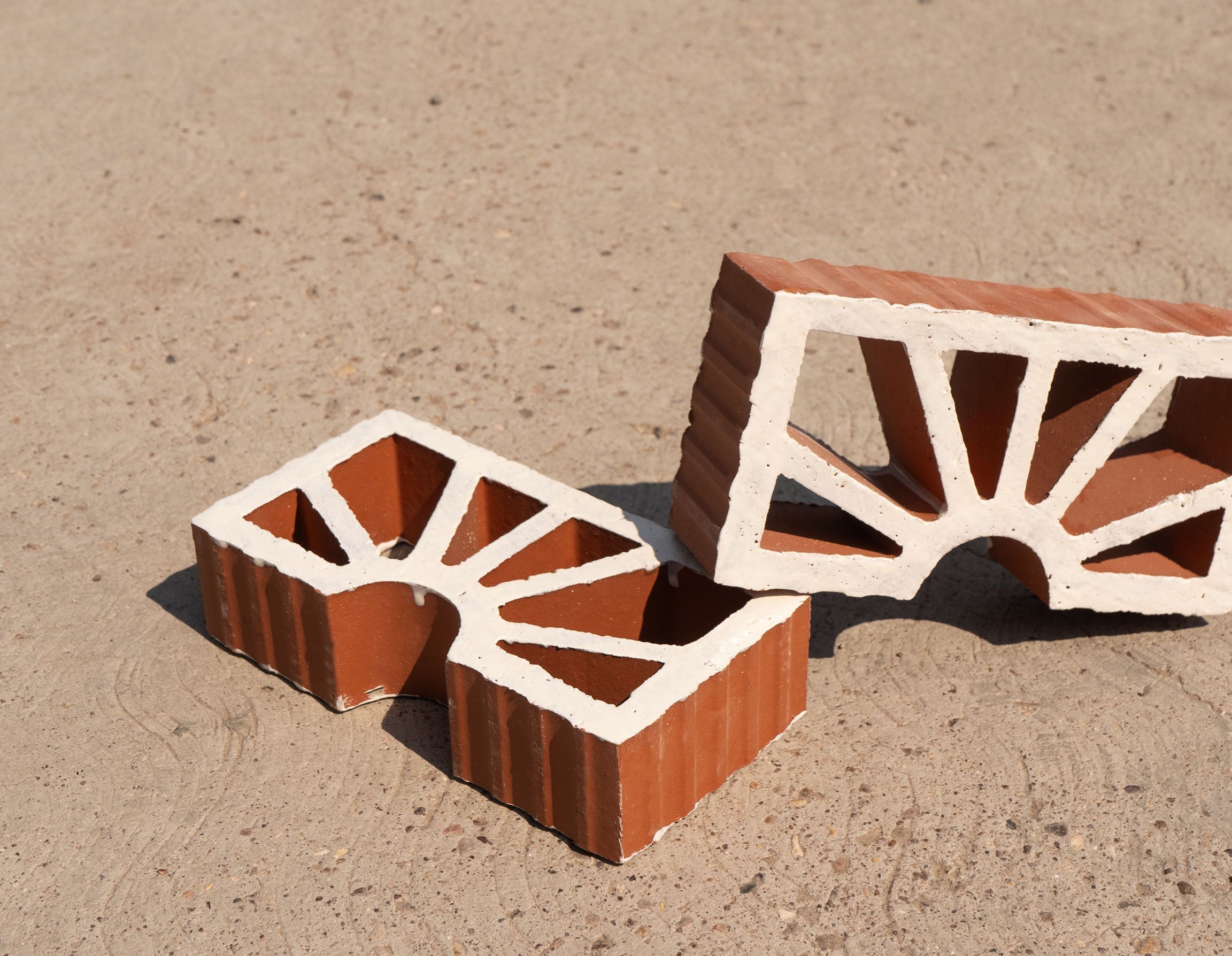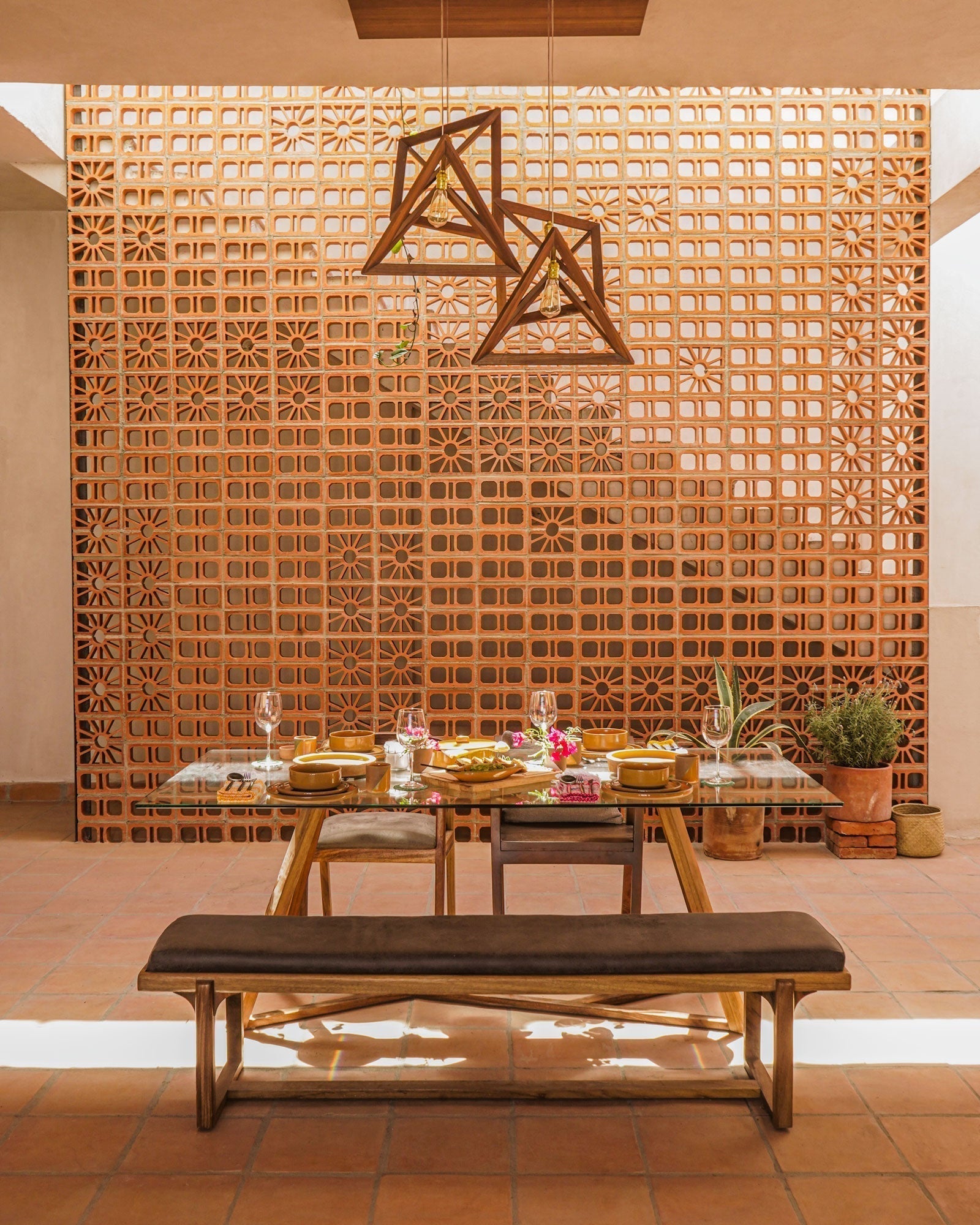By Clay Imports
If you're searching for the ultimate Mid-Century Modern accent, your search ends here. Terracotta breeze blocks, also known as screen blocks, are making a stylish comeback! Find these beautifully designed blocks exclusively at Clay Imports.
From sourcing to design inspiration and installation, we've got you covered.
- What are Terracotta Breeze Blocks?
- Where Are Terracotta Breeze Blocks Made?
- How Are Terracotta Breeze Blocks Made?
- What Breeze Block Design Options Are Available?
- Where Can Terracotta Breeze Blocks Be Installed?
- How To Install a Breeze Block Wall?
- Do I Need to Seal Terracotta Breeze Blocks? Can I Paint Them?
- Where do I order Terracotta Breeze Blocks?
Want the overview? Check out the Clay Imports Ultimate Breeze Block Guide.
What are Terracotta Breeze Blocks?
Terracotta breeze blocks have been adorning buildings across the globe for decades. Their distinctive patterns make them a popular decorative feature in trendy eateries, modern homes, and outdoor spaces.
But they’re more than just visually appealing. Breeze blocks help regulate sunlight, enhance ventilation, and add a touch of functional beauty to patios and breezeways.
Introduced in American design in the 1930s, breeze blocks saw rapid growth in popularity through the 1970s, particularly in warm locations like Palm Springs. Today, they’re experiencing a revival in modern design as architects and designers find innovative ways to use them.

Innovative application of Ventana breeze blocks at the Lela Rose Dallas flagship | Photo by Lisa Petrole.
Our version of these iconic blocks blends West Coast Mid-Century Modern aesthetics with Mexican contemporary architecture. However, keep in mind that terracotta breeze blocks are decorative and not intended for structural use.
Where are Terracotta Breeze Blocks Made?
We produce our Clay Imports breeze blocks in Mexico, using 100% natural clay sourced from Central Mexico. Handmade with care, these blocks embody authentic Mexican craftsmanship.
For more insights, check out our YouTube channel for videos and tutorials.
How Are Terracotta Breeze Blocks Made?
Our clay breeze blocks showcase bold geometric patterns reminiscent of Art Deco design, combining excellent craftsmanship with a modern touch. Here’s a simplified overview of the production process:
- Dense red clay is extracted and pressed through a patterned mold (similar to using a Play-Doh mold).
- The blocks are fired at high temperatures to harden and set their structure.
- The final product is a durable, decorative breeze block ready for installation.
Step-by-step process of crafting terracotta clay breeze blocks, revealed in video.
What Breeze Block Design Options Are Available?
We offer a variety of breeze block sizes and patterns, including floral motifs, geometric lines, and square grids.
All our blocks come in classic red terracotta with consistent color tones throughout. Prefer a different color? You can paint them! Check out our video on how to paint breeze blocks, or avoid this step and get our durable glazed breeze blocks.

Close-up of our Petalo glazed breeze blocks in white.
Where Can Terracotta Breeze Blocks Be Installed?
You'll love how our breeze blocks separate and define spaces, creating an impressive design. They also provide sun protection and allow for ventilation, depending on the size of the breeze blocks used in your wall. Outdoors, a breeze block wall can offer privacy while maintaining airflow.
A clay breeze block wall can completely transform your outdoor spaces. However, you can also use it indoors to add decorative elements or create subtle room divisions. One of our favorite design uses for breeze block walls is as a focal point—whether in an entryway, as a partition wall, or even as a stylish bar face.
More ways to use breeze block walls:
- Front Yard: Screen off your space from the street while allowing natural light to filter through.
- Back Porch: Create a well-ventilated, shaded oasis in your backyard.
- Partition Walls: Indoors or outdoors, breeze block walls add structure while maintaining an open feel.
- Outdoor Paving: Elevate your walkway with a design as beautiful as the destination.
- Commercial Projects: Add modern texture and depth to any commercial space.
How To Install a Breeze Block Wall?
Here are key recommendations:
General Installation Tips:
- Build on a solid, durable surface.
- Use adhesive or masonry cement to bond the blocks.
- Consult local building codes for structural integrity.
Recommended Structural Support:
- Vertical beams every 8 feet (2.44 m) for added stability.
- Maximum wall height: 9 feet (2.74 m) without additional reinforcements.
- Use ladder wire and 3/8" rebar for extra support.
Grout Joints:
- Conventional masonry installation: 3/8" to 1/2" grout joints.
- Technical adhesive installation: Minimum 1/4" grout joint, filled with sanded grout.
For larger projects, we recommend hiring a professional masonry contractor.

Exterior breeze block wall reinforced with rebar and concrete columns.
Design and Build Rodney & Jake
Installation Methods
Conventional Masonry Cement
- Mix mortar according to the manufacturer’s instructions.
- Apply mortar on the footing and place the first breeze block.
- Use a level to ensure accuracy.
- Continue placing blocks, applying mortar between them.
- Cut blocks as needed using a masonry wet saw.
- Allow the mortar to cure according to the instructions.
Technical Installation (Adhesive Method)
- Apply ProLite® Premium Large Format Tile Mortar or liquid nails.
- Adhere the blocks together with spacers.
- Remove spacers and fill grout joints with sanded grout.
- Choose any grout color to complement your design.
Outdoor Paving Installation
Breeze blocks can also be used as a decorative pathway or driveway. Consult a professional for best results.
Inserting Breeze Blocks Into Existing Walls
Integrate breeze blocks into existing stucco or masonry walls during construction. This method adds an architectural feature while maintaining structural integrity.

Technical Information
- Load Capacity: 2300 psi
- Water Absorption: 0.5% - 3%
- Abrasion Resistance: C4
- Scratch Hardness: MOHS 6
- Coefficient of Friction: C3
- Shade Variation: V2
Do I Need to Seal Terracotta Breeze Blocks? Can I Paint Them?
Terracotta breeze blocks are porous since they're made of clay. That means they can be stained during grouting. To prevent staining, we advise you seal the blocks prior to grouting.
Although not required, we recommend sealing your blocks with Miracle 511 Impregnator Sealer as it will maintain the natural clay look. The sealer can be rolled or brushed onto the front and back with a penetrating sealer, making sure to avoid the top, bottom, and sides of the block. Let dry and proceed with installation.
There are two painting methods. Dip painting can be done with a Masonry Stain (pigment you mix with water). Or you can use an epoxy-based paint and spray it on to the raw clay block with an air sprayer. Either way, let it dry, then install!
Where do I order Terracotta Breeze Blocks?
Browse our selection of breeze blocks. We recommend ordering samples to fully appreciate the texture and color before committing to a large order.
We can't wait to see our terracotta breeze blocks in your projects! If you have any questions or need more details, feel free to reach out to us, we’re happy to help!




 Share
Share
 Pin it
Pin it





